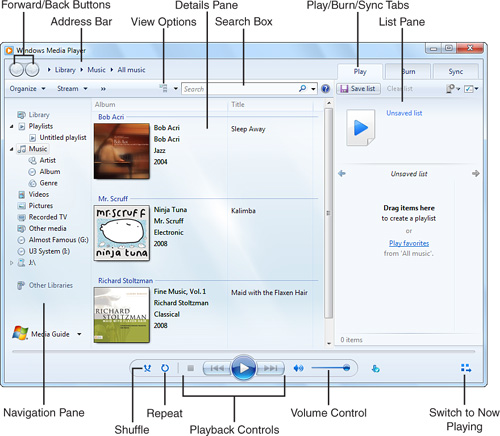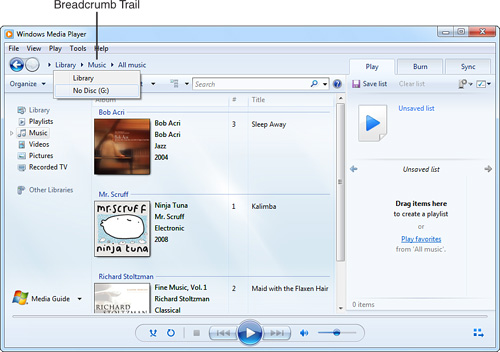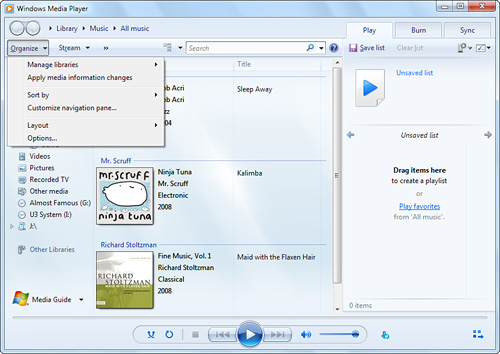Windows Media Player (WMP) has grown into a pretty
amazing application with multiple personalities. Its talents include
playing music and video files from online sources or local drives
(including DVDs), playing online radio and TV stations, displaying
specialized web pages, organizing your music files (MP3s and WMAs),
burning music CDs, copying and syncing to portable MP3 players, and
providing a conduit to online media shopping sites. Windows 7 includes
an updated version of WMP that sports a refreshed user interface,
additional features, and some much-welcomed interoperability. WMP 12
has divided Now Playing and Library views into separate interfaces.
1. Media Types Compatible with WMP
WMP can play the file types shown in Table 1.
Table 8.1. Windows Media Player–Supported File Types| File Type | Filename Extension(s) |
|---|
| Music CD (CD audio) | .cda | | Intel Indeo video | .ivf | | Audio Interchange File Format (digitized sound) | .aif, .aifc, .aiff | | Windows Media (audio and video) | .asf, .asx, .wax, .wm, .wma, .wmd, .wmv, .wvx, .wmp, .wmx, .wpl | | Windows Media Center video | .dvr-ms | | Windows video and audio | .avi, .wav | | QuickTime content | .mov, .qt | | Windows Media Player skins | .wmz, .wms | | MPEG (Motion Picture Experts Group) video | .mpeg, .mpg, .m1v, .mp2, .mpa, .mpe, .mp2v, .mp2, .mp4 | | AU (UNIX audio) | .au, .snd | | MP3 (digital audio) | .mp3, .m3u | | MIDI (Musical Instrument Digital Interface) | .mid, .midi, .rmi | | DVD video | .vob | | Advanced Audio Coding | .aac | | Formats not supported: RealNetworks (.ra, .rm, .ram), iTunes (.m4p, .acc). |
|
Windows
7 versions that include Media Center have native DVD playback
capability. If your version of Windows 7 does not contain Media Center
and you want to play back DVD video and .mp2v
files, you must first install a hardware or software DVD decoder on
your system. (If you insert a DVD and it doesn’t run, it’s likely you
need an appropriate video coder/decoder, or codec, or the DVD has
copyrighted content playback restrictions.) WMP 12 attempts to
automatically detect required codecs and provides a download location
where applicable.
Installing a decoder is
typically a simple software update you can download from the Web. To
get a DVD decoder, search the Web for WinDVD or Power DVD.
The decoder will cost you a few bucks, probably around $10. (Although
current boxed editions of both players are around $50–$60.)
|
2. Getting Around in Windows Media Player 12
WMP 12 has a redesigned user interface, as shown in Figure 1,
to make it easier for you to manage and enjoy your digital media. The
classic menus still exist (hidden by default) but navigational tabs
have been replaced by simplified breadcrumb navigation, making managing
and viewing your digital media easier than ever. The Now Playing
drop-down button is still there, but it’s now relocated in the
bottom-right corner of the Library view. Now Playing now operates in a
separate control window.

Navigating Menu Breadcrumbs
The breadcrumbs in WMP 12, shown in Figure 2,
provide a way to quickly focus on the task you want to perform by
giving you efficient access to lower-level categories (for example,
Library > Playlists, or Library > Music > Artist).

The
breadcrumb navigation trail is accessible from the top of the WMP 12
window (the Address bar) and provides instant access to and easy
browsing of your stored media. Just under the breadcrumb navigation is
a new toolbar that enables you to perform the following tasks:
Library—
Use this feature to organize and locate your favorite media types
you’ve downloaded or created. As you download and create music, WMP
automatically generates album and artist information for audio and
video content. You also can view content by type and by genre. Tip Many
visualizations are available online for use with WMP 12. A personal
favorite of mine called PixelTrip can be obtained from the WMP website
at www.wmplugins.com/ItemDetail.aspx?ItemID=881. Another excellent visualization is provided by Brian Spangler and is called TwistedPixel. You can download it from his website for free at www.visolu.com/TwistedPixel. |
No Disc— The title of this category defaults to No Disc if no media disc is in your CD or DVD-ROM drive; otherwise, it assumes
the name of the volume stored in that drive.
Tip When
you copy music, WMP can prevent copied tracks from being played on any
other computer to limit distribution and enforce media usage rights for
copyright-protected music. If you want to disable this feature so that
you can move copied music from one PC to another, choose Organize,
Options and select the Rip Music tab. Then uncheck the Copy Protect
Music check box under Rip Settings. |
WMP
12 groups and relocates options for Play, Burn, and Sync to a separate
window pane off to the right side, with tabs for each as follows:
Play—
Drag and drop items to create a playlist and save or clear playlist
entries. WMP 12 also makes audio and video playback easier on remote
devices with the Play To icon (placed to the right of Clear List and
next to List Options), which remains gray until you connect a media
player device. The List options button reveals settings to hide, sort,
and save lists, as well as skipped playlist entry options, and help
topic access. Burn—
After you download or convert music tracks to WMA format, use this
feature to transfer your music mix to writable CDs (CD-R or CD-RW
media). Sync—
After you download or convert music tracks to WMA format, use this
feature to transfer your music mix to portable audio players designated
“Compatible with Windows 7.”
Tip Be
sure you fill your CD with all the music you want to play; unlike
conventional CD-mastering programs or Windows 7’s Copy to CD feature in
other parts of the OS, WMP’s Copy to CD feature closes the CD (so it no
longer can accept data) after you copy your selected music to it, even
if you use only a small portion of the CD. Why? Standalone CD players
are designed to handle single-session CDs and won’t work if you add
music later. If you want to create a CD for playback on your computer,
use Windows Explorer’s Copy to CD feature instead, which will allow you
to copy music over several sessions. |
Isolated
at the bottom-left corner is a button labeled Media Guide. This option
enables you to purchase media online or select from a variety of online
content.
The menus below each button
provide quick access to settings and options relevant to the task of
that tab. For instance, as shown in Figure 3,
the arrow below the Organize button provides the options for managing
libraries, sorting media selections, layout options, and quick access
to the Options dialog.

Tip To
show the classic menus, right-click an empty area of the taskbar or an
empty area around the playback controls and select Show Menu Bar or
press Ctrl+M. |
|